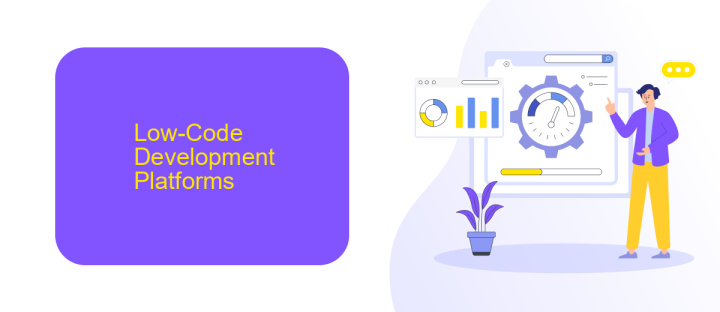Low-Code and No-Code Development Platforms
Low-code and no-code development platforms are revolutionizing the software industry by enabling users with minimal programming skills to create robust applications. These platforms offer intuitive interfaces, drag-and-drop features, and pre-built templates, significantly reducing development time and costs. As businesses strive for digital transformation, low-code and no-code solutions are becoming essential tools for rapid innovation and efficiency.
Introduction
Low-Code and No-Code Development Platforms are revolutionizing the way applications are built by enabling users to create software with minimal or no coding experience. These platforms provide visual interfaces and pre-built templates that simplify the development process, making it accessible to a broader audience.
- Accelerated development timelines
- Reduced costs
- Enhanced collaboration between technical and non-technical teams
- Greater flexibility and scalability
One significant advantage of these platforms is their ability to integrate with various services effortlessly. Tools like ApiX-Drive facilitate seamless integrations, allowing users to connect different applications and automate workflows without writing complex code. This ease of integration further enhances the efficiency and functionality of low-code and no-code solutions, making them an attractive option for businesses of all sizes.
Low-Code Development Platforms

Low-code development platforms offer a streamlined approach to software development, enabling users to create applications with minimal hand-coding. These platforms provide a visual interface where users can drag and drop components, making it easier for those with limited programming knowledge to participate in the development process. By abstracting much of the underlying code, low-code platforms significantly reduce the time and effort required to build functional applications, thus accelerating the development lifecycle.
One of the key advantages of low-code platforms is their ability to integrate with various services and systems effortlessly. For instance, ApiX-Drive facilitates seamless integration of different applications and services, allowing developers to automate workflows without extensive coding. This capability is crucial for businesses looking to streamline operations and improve efficiency. By leveraging low-code development platforms and tools like ApiX-Drive, organizations can quickly adapt to changing market demands and stay competitive.
No-Code Development Platforms

No-code development platforms empower individuals to create applications without the need for traditional programming skills. These platforms provide intuitive drag-and-drop interfaces, enabling users to design and deploy software solutions quickly and efficiently.
- Visual Development: Users can build applications using visual tools and pre-built templates.
- Integrations: Platforms often offer seamless integration with various third-party services and APIs. For instance, ApiX-Drive allows users to connect and automate workflows between different applications without any coding knowledge.
- Scalability: No-code platforms are designed to scale with the growth of the application, ensuring that performance remains optimal as user demands increase.
These platforms democratize software development, making it accessible to a broader audience. By reducing the dependency on skilled developers, businesses can accelerate their digital transformation initiatives and respond more swiftly to market changes. No-code solutions are particularly beneficial for small and medium-sized enterprises looking to innovate without extensive IT budgets.
Benefits and Challenges of Low-Code/No-Code Platforms

Low-code and no-code development platforms offer significant benefits by enabling users to create applications with minimal coding knowledge. These platforms democratize software development, allowing business professionals to contribute to app creation, thus accelerating the development process and reducing costs.
Despite these advantages, there are also challenges associated with using low-code/no-code platforms. One major concern is the potential for limited customization, as these platforms may not offer the same flexibility as traditional coding methods. Additionally, there can be security and scalability issues, especially for complex enterprise-level applications.
- Faster development cycles
- Reduced development costs
- Empowerment of non-technical users
- Potential security and scalability concerns
- Limited customization options
Integrating low-code/no-code platforms with existing systems can also be a challenge. However, services like ApiX-Drive simplify this process by providing seamless integration solutions. By leveraging such tools, businesses can ensure that their low-code/no-code applications work harmoniously with other essential software, enhancing overall efficiency and productivity.


Use Cases and Future of Low-Code/No-Code Development
Low-code and no-code development platforms are transforming various industries by enabling rapid application development with minimal coding. These platforms are particularly useful for creating internal business tools, automating workflows, and developing customer-facing applications. For instance, companies can streamline their operations by automating repetitive tasks and integrating multiple services without extensive programming knowledge. Platforms like ApiX-Drive facilitate these integrations, allowing businesses to connect different applications and automate data transfers seamlessly.
The future of low-code and no-code development looks promising, with advancements in artificial intelligence and machine learning expected to enhance their capabilities. As these platforms evolve, they will likely offer more sophisticated features, making them suitable for even more complex applications. Additionally, the democratization of software development will continue, empowering non-technical users to create and manage their own applications. This shift will not only reduce development costs but also accelerate innovation across various sectors.
FAQ
What are Low-Code and No-Code Development Platforms?
What are the main benefits of using Low-Code and No-Code Platforms?
Can Low-Code and No-Code Platforms be used for enterprise-level applications?
How do Low-Code and No-Code Platforms handle integrations with other systems?
Are there any limitations to using Low-Code and No-Code Platforms?
Do you want to achieve your goals in business, career and life faster and better? Do it with ApiX-Drive – a tool that will remove a significant part of the routine from workflows and free up additional time to achieve your goals. Test the capabilities of Apix-Drive for free – see for yourself the effectiveness of the tool.

